Réinitialiser votre mot de passe WordPress est généralement un processus simple. Cependant, il arrive que les méthodes standard ne fonctionnent pas, vous laissant bloqué hors de votre site.
Certains de nos lecteurs ont rencontré ce problème et nous ont demandé conseil sur la meilleure façon d’accéder à leur compte. Heureusement, vous pouvez toujours utiliser l’outil phpMyAdmin dans le panneau de configuration de votre compte hébergeur pour réinitialiser directement votre mot de passe à partir de la base de données WordPress.
Dans cet article, nous allons vous afficher comment réinitialiser facilement un mot de passe WordPress à partir de phpMyAdmin. Nous expliquerons chaque étape clairement, en veillant à ce que même si vous n’êtes pas familier avec les bases de données, vous puissiez suivre en toute sécurité.
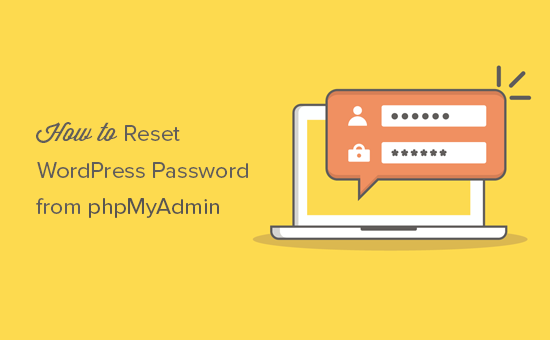
Pourquoi réinitialiser un mot de passe WordPress depuis phpMyAdmin ?
WordPress facilite grandement la récupération d’un mot de passe perdu.
Il vous suffit de vous rendre sur l’écran de connexion de votre site WordPress et de cliquer sur le lien ” Vous avez perdu votre mot de passe ? “.
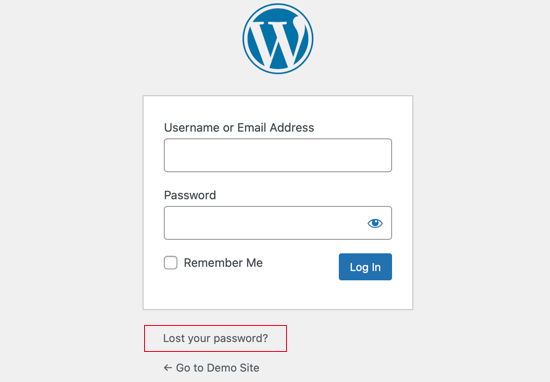
Lorsque vous cliquez sur le lien, vous accédez à la page de réinitialisation du mot de passe. Lorsque vous saisissez votre nom d’utilisateur ou votre adresse e-mail, WordPress envoie un lien de réinitialisation du mot de passe à l’adresse e-mail saisie.
Toutefois, si vous n’avez pas accès à cette adresse e-mail, ou si votre site WordPress n’envoie pas d’e-mail, vous ne pourrez pas réinitialiser votre mot de passe.
Dans une telle situation, vous devrez réinitialiser votre mot de passe WordPress directement dans la base de données. La manière la plus simple de le faire est d’utiliser phpMyAdmin.
Ceci étant dit, voyons comment réinitialiser facilement un mot de passe WordPress à partir de phpMyAdmin.
Comment réinitialiser un mot de passe WordPress à partir de phpMyAdmin
Si vous ne souhaitez pas regarder le tutoriel vidéo, vous pouvez continuer à lire la version texte ci-dessous.
Tout d’abord, vous devez vous connecter au Tableau de bord WordPress de votre hébergeur. Ensuite, vous devez naviguer jusqu’à la section Bases de données où vous pouvez cliquer sur l’icône phpMyAdmin.
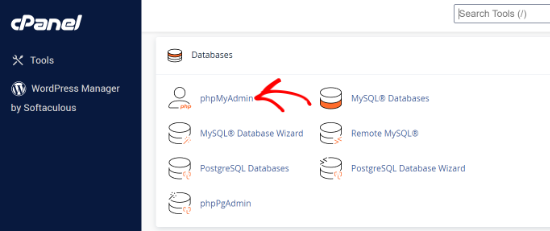
Ceci lancera l’application phpMyAdmin.
Ici, vous devez sélectionner votre base de données WordPress dans le panneau de gauche.
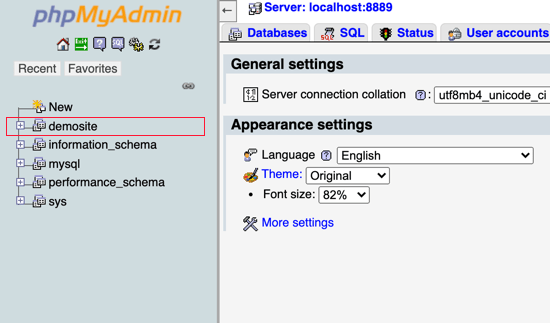
Vous verrez maintenant la liste des tables de votre base de données WordPress.
Vous devez rechercher le tableau wp_users dans cette liste et cliquer sur le lien “Parcourir” situé à côté.
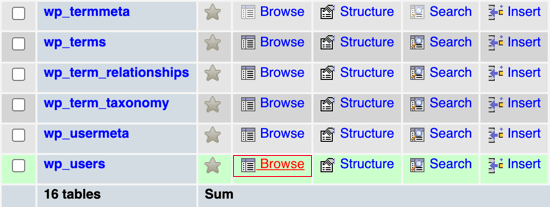
Note : Les noms de tables dans votre base de données WordPress peuvent avoir un préfixe différent de celui que nous affichons dans notre capture d’écran. Modifier les préfixes des tables peut améliorer la sécurité de votre site WordPress.
Vous verrez maintenant les lignes de votre tableau d’utilisateurs/utilisatrices WordPress. Allez-y et cliquez sur le bouton modifier à côté de l’identifiant dont vous souhaitez modifier le mot de passe.
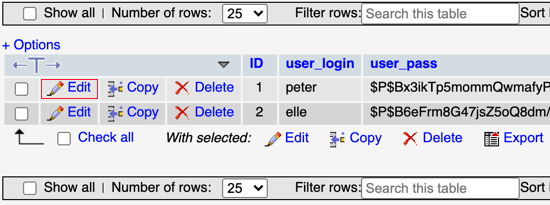
PhpMyAdmin affichera un formulaire avec tous les champs d’information sur les utilisateurs/utilisatrices.
Vous devrez supprimer la valeur du champ user_pass et la remplacer par votre nouveau mot de passe. Dans la colonne fonction, sélectionnez MD5 dans le menu déroulant, puis cliquez sur le bouton Go au bas du formulaire.
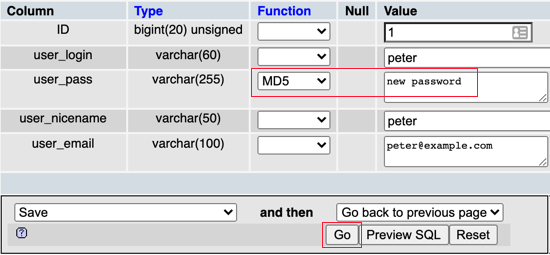
Votre mot de passe sera chiffré à l’aide du hachage MD5, puis il sera stocké dans la base de données.
Félicitations ! Vous avez bien modifié le mot de passe de WordPress en utilisant phpMyAdmin.
Certains d’entre vous se demandent peut-être pourquoi nous avons sélectionné le hachage MD5 pour chiffrer le mot de passe. WordPress utilisait auparavant le hachage MD5 pour crypter les mots de passe, mais depuis WordPress 2.5, il utilise des technologies de chiffrement plus puissantes.
Cependant, WordPress reconnaît toujours le MD5 pour assurer la compatibilité ascendante. Dès que vous vous connectez en utilisant une chaîne de mots de passe stockée sous forme de hachage MD5, WordPress la modifie automatiquement pour utiliser les algorithmes de chiffrement plus récents.
Guides d’experts sur les mots de passe dans WordPress
Maintenant que vous savez comment réinitialiser un mot de passe WordPress depuis phpMyAdmin, vous pouvez consulter d’autres articles liés aux mots de passe dans WordPress.
- Comment modifier votre mot de passe sur WordPress (Guide du débutant)
- Comment réinitialiser les mots de passe de tous les utilisateurs/utilisatrices dans WordPress
- Outil de personnalisation de la page de réinitialisation du mot de passe de WordPress
- Comment forcer les utilisateurs/utilisatrices à modifier leur mot de passe sur WordPress – Expire Password
- Mot de passe oublié ? Comment récupérer un mot de passe perdu sur WordPress
- Comment forcer les utilisateurs/utilisatrices à utiliser des mots de passe forts dans WordPress
- Comment ajouter l’authentification à deux facteurs dans WordPress (méthode gratuite)
- Comment permettre aux utilisateurs de masquer/afficher leur mot de passe sur l’écran de connexion de WordPress ?
- Comment gérer facilement et en toute sécurité les mots de passe (Guide du débutant)
Nous espérons que ce tutoriel vous a aidé à apprendre comment réinitialiser un mot de passe WordPress depuis phpMyAdmin. Vous pouvez également consulter notre guide ultime de sécurité WordPress étape par étape pour garder votre site WordPress en sécurité ou notre choix d’experts des extensions incontournables.
Si vous avez aimé cet article, veuillez alors vous abonner à notre chaîne YouTube pour obtenir des tutoriels vidéo sur WordPress. Vous pouvez également nous trouver sur Twitter et Facebook.





Graham
THANK YOU!!
I was caught up on the md5 encryption of the pw field. This really save my tail. I was using a member profile update which stripped all the email fields. This in turn also stripped mine and poof! Everyone’s password was deleted.
Seriously.
So, thank you a lot.
-Graham
Karen Seet
How do I find my “hosting provider” so I can get to phpmyadmin? I am new to this.
Muhammad Talha
Thanks a lot!
Edwin Calimlim
Great post, i wasn’t able to access my WP site for months already but thanks to this post, it is really a big help for me. Thank you.
atif shahab
Thanks alot. I was worried and stuck as well as i was unable to acess my WordPress dashboard for 2 hours. your recipe worked quickly. Thanks once again
WPBeginner Support
Glad it helped you solve the issue
Admin
Niculina
Thanks!! it worked! :):)
Joel
Lifesaver, thank you!
alan
What a fantastic email, new to C-panel but this tutorial was so clear I did it first time.
Great job.
Regards,
Alan
Trevor
Thank you !!!
Pedro
Did this now Jetpack gives me this error :
Jetpack could not contact WordPress.com: register_http_request_failed. This usually means something is incorrectly configured on your web host.
Operation timed out after 15000 milliseconds with 0 bytes received
Any tips on this?
Margie
Thank you so much. The instructions were easy enough for even me to follow
Carina
I wish it worked for me……I followed the directions [easy] but when I went to put in the MD5 hash numbers, they were exactly the same as what was already in the field value. This tells me that my problem is then not entering my user name and password that is the problem, but something completely different. …..:(
Thom Burlington
Thank you, but ..
while I can now reset the password with the MD5 code, derived from the new password I created, say, “abc” , and I finish and go back to my wordpress adimin signin:
domain.org/wp-admin : username ; password
for the password do I now use “abc” ?
Thom Burlington
Yes the password is “abc” – very nice – between your post and the video you are very clear, thank you.
Neal Kelshaw
Not quite correct. If you choose MD5 as the function in the drop down menu, and then type the password in plain text it hashes the value to an MD5 value.
tobi
awesome post thanks a lot
Jon O
Just wanted to say a BIG thank you for this article! I was indeed hacked and had sought assistance from my hosting company and others.. but this article was the only straight forward approach that worked first time! Thanks so much!
WPBeginner Support
Glad you found it helpful.
Admin
Tanya
I spent hours trying to find a website to explain why I was logged onto my WP then 5 minutes later I couldn’t log onto it again.
Thank you so much for the simple video. Problem solved in 5 minutes!
You rock!
WPBeginner Support
Glad you found it helpful.
Admin
Creina
Thank you. For anyone that finds the video confusing just follow the written instructions.
ashish
thank you so much for this tutorial…
Dairick
Thank you for this turorial
Parbat Devkota
thank you work charm.
Alexandra Jones
I’m the dunce from Mars who can’t speak computer. I’ll start with this:
“The best place to look is your wp-config.php file which is located in your root WordPress Directory.”
OK–where is it and how do I get there? I can’t log into my site because it will not any accept any password resets. I tried Chris’s phone method and got in on my phone, but not on my laptop. and when I tried to post something on the phone, I got a message that I should install the latest Jetpack, but I had to log into WordPress again, and guess what–“Invalid username.”
Is any of you who found these instructions such a breeze willing to speak to me on the phone? I’m writing from my wit’s end. That’s where I am. I would so appreciate it! Cheers!
WPBeginner Support
wp-config.php file resides on your web server. You can login to your web hosting control panel, locate the file manager, and then locate wp-config.php file. Alternately, you can also edit it using an FTP client.
Admin
Zania
Thank You! Thank You! Easy and worked like a charm!
chrismj06
You have saved my life. Bless u!
Jill
Thanks, you’re a lifesaver and this was easy to follow!
Kristen
You saved the day! Thank you!
AMIT KUMAR
Thank you ! I was simply trying to enter password. I never knew about the MD5 concept. Thanks again for a great tutorial.
Silviu
Thank you
Dubb
Awesome…you have saved the day once again my friend
Nigel
Awesome, thanks.
Skye
THANK YOU!!!!! Great article!
Kumar
Work like charm!!
hendriyana
Thanx !!! awesome.. helped for my problem….
Jaykesh
Amazing, thanks for quick help.
luis
Thanks a lot, I went into php admin and copy pasted the md5 password and i am in…..good job!
Muniyappa
Thank you very much..
Tony Garcia
A client’s developer passed away while on vacation of all things. You can only imagine what happened after that. Nobody knew anything of how their developer was doing things. Luckily I was able to locate where their databases were and got access to their PHPMyAdmin.
Voila!!! I have both of their lost sites back up and running with access to the back-ends because of this post.
Thank you!!!
Carol Long
Thank you! Life saver!
Lori
This saved me ENDLESS time. I’m not a tech novice but I am a novice at coding. These step by step instructions helped me regain access to my site! After losing access due to a “auto correct” error. (long story)
Thank you again!
christian gibson
You say that WordPress generates an MD5 encryption of your password? But I seem to remember seeing somewhere on Stackoverflow that this is no longer true. They said: “The WordPress password hasher implements the Portable PHP password hashing framework, which is used in Content Management Systems like WordPress and Drupal”.
I know very little about encryption/decryption systems, but one thing does seem strange. In a WordPress website database you can can see in the user table a field called ‘user-pass’ with contents like ‘$P$BlBAsz6jcvS3rLGDiE81PwtwbEazKg1’.
All the hash values in this table begin with $P$B….. so what on earth is the point of including these leading 4 characters if they are all the same……?
Samson
Thank you very much. saved me valuable time
Rod Salm
As always, straight forward, very helpful tutorials. Right to the point and bang on accurate. Like this phpadmin tip for passwords.
Thank you!
Ben Glancy
Or, if your admin account is the usual ID=1.
Open functions.php and put this code in
wp_set_password( “mypassword”, 1 );
Reload the page.
Uncomment code. Done.
Diana
Soooo helpful! Thank you!!!!
raaga
Thanks man. Very useful article.
Matthew Harris
Thanks for the tip, I couldn’t quite remember. Here is a return tip for you:
You don’t need the external MD5 tool. Look on the screenshot there is a “Function” column with drop down boxes. On the user_pass field just select MD5 in the function column and type your new password in normal plain text in the input box next to it. When you save it phpMyAdmin will automatically md5 hash it for you.
Amir
Great article. I found Matthew Harris’ tip simpler and tested it to work as well. Thanks!
Julian
Mr. Harris approach worked like a charm! Thank you.
Kevin B.
Very helpful. As a non-technical user, I felt powerless when an errant designer wouldn’t respond to my requests for passwords; this page with instructions filled the bill perfectly!
Many thanks,
KB
alex
Thanks!
Gustavo
Thanks for this great tip. I tried the “easiest” way above but couldn´t retrieve the automatic email because of some misterious server glitch.
I don´t know beans of PhP, so this kind of article is very useful for us.
Chris
I found the easiest and fastest work around the “Sorry, that key does not appear to be valid” issue to reset your WordPress password using your cell phone.
1.) Just use your cell phone to access your password reset email that was sent to you.
2.) Click on the link in the email. The link will automatically open the site where you can input your new password.
3.) Follow the prompts to enter your new password.
4.) Save your new password
5.) You should now be able to access your WordPress website with your new password from any computer, business as usual.
I hope this helps everybody!